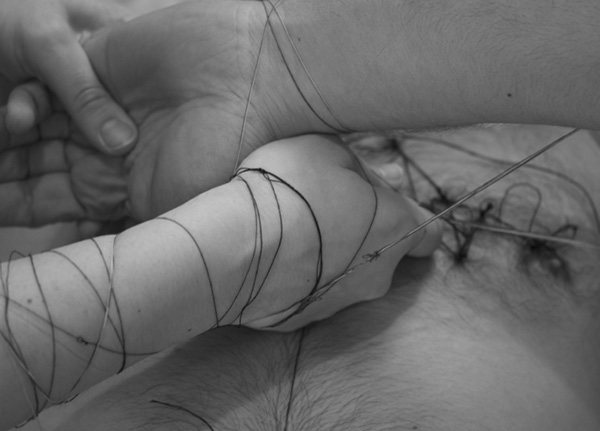
ONE THOUSAND STITCHES III
first performed on
May 24, 2011
Collective Studio, Toronto, Canada
performed once in 2011
MARYAM TAGHAVI
Toronto, Canada
364763987m364763987a364763987r364763987i364763987a364763987m364763987t364763987a364763987q364763987a364763987v364763987i364763987@364763987g364763987m364763987a364763987i364763987l364763987.364763987c364763987o364763987m
mariamtaqavi@gmail.com
ONE THOUSAND STITCHES III
MARYAM TAGHAVI
This photograph is an excerpt from the third episode of an ongoing series titled “One Thousand” which references durational elements of performance. The artist begins by gently stitching and embroidering the model’s chest hair in a pattern. She announces the completion of each stich by calling its number. The needle and string mark points of contact for proceeding gestures that slowly adapt a more aggressive tone and establish a more violent relationship as the artist adds her own fingers, hand and arm to his chest. Consequently this action brings bodies in full contact. Towards the end the action of stitching implies the use of a weapon. Despite creating an intimate contact, the bodies are deprived of desire and affinity due to tension witnessed earlier. The bodies are finally separated using a blade to cut the string, only to leave the visible string marks upon them. The male model has to trim his hair to remove the stiches. Using domestic settings and intimate gestures, these performances comment on constructed behavioral models that negate their initiative intents in the course of action. These models are internalized and embodied but their practice may consequently not be only against but also damaging to its founding notions. The restricting nature of behavioral models, often presented as taming and domesticating are highly charged with suppressing forces that are impregnated by violation and aggression. These performances display the embodiment of an arbitrary principle and the marks entailed by its practice. Some of the performances in this series deal with the process of undoing marks caused by these actions.